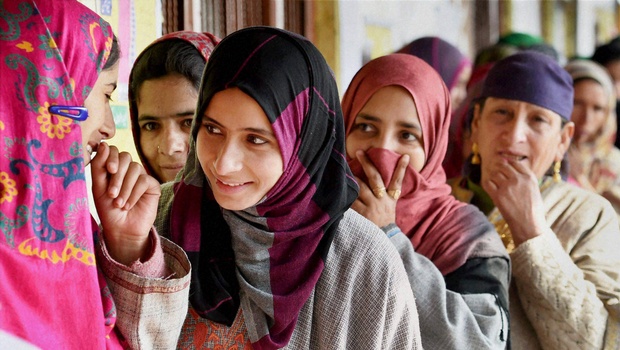Srinagar/Ranchi, Dec 23: Jammu and Kashmir today returned a hung verdict with PDP as a dominant party that can tie up either with the Congress or BJP in forming the Government as BJP and its allies appeared headed for capturing power in Jharkhand.
Prime Minister Narendra Modi's vigorous campaign in Jammu and Kashmir failed to make a breakthrough in the Valley but made it a dominant party in the Jammu region where it has won three seats and is ahead in 22 of the 37 seats.
The PDP, which has emerged as the single largest party in Jammu and Kashmir winning is ahead in 33 seats including two seats already in its bag, appeared to be in the pole position to form the government in the 87 member Assembly.
The party headed by Mufti Mohammed Sayeed can choose to form the government either with the support of Congress which is leading in 11 seats and has won one seat or the BJP. The Congress and PDP had formed a government together in 2002.
The ruling National Conference suffered a rout plummeting from 28 seats it won in 2008 to 11 including one seat in its bag. Chief Minister Omar Abdullah lost from Sonawar, one of the two seats he contested from while trailing in Beerwah.
Interestingly, senior PDP leader Muzaffar Hussain Beigh gave mixed signals when he said it would be easier for his party to go together with Congress than BJP but felt that BJP cannot be treated as an "untouchable".
On the other hand, Congress leader Ghulam Nabi Azad, who led the party's campaign in the state, said it was "open" to aligning with PDP.
In Jharkhand, the BJP and its ally AJSU headed by Sudesh Mahto were well on the road to forming a coalition government. The BJP was leading in 35 seats of the total 81 seats while AJSU was ahead in four seats.
With just two seats short of majority, the two may have no difficulty in staking claim with support from small parties and independents who account for 10 seats including six of JVM(P) headed by former BJP Chief Minister Babu Lal Marandi.
The ruling JMM, ironically, put up a better show leading in 19 seats and winning one against 18 it had won in the last elections. Chief Minister and JMM candidate Hemant Soren is leading in Barhait constituency but is trailing in Dumka, the other seat he is contesting.
The Congress, which was part of the government in Jharkhand, was leading in seven seats against 14 it had won in the last elections. Its ally RJD is ahead in two seats down from five in 2009.
BJP had got its share of 32 legislators in the 81-member House after the creation of Jharkhand on November 15, 2000 and formed a government with the support of JD (U)and some other parties.
It's number rose to 33 after Babulal Marandi won a by-poll from vacant Ramgarh seat after becoming the first Chief Minister of Jharkhand.
The party's tally slightly came down to 30 seats in the first assembly elections held in the state in 2005. The 2009 Assembly elections, however, saw its numbers reduced to 18.
While Marandi's party JVM(P) was leading in eight seats, the former Chief Minister who parted ways with BJP long back was trailing at third position in his assembly seats in Giridih and Dhanwar.
While BJP National Vice-president Raghubar Das is forging ahead is Jamshedpur East seat, its heavyweight in the state and former Chief Minister Arjun Munda is trailing in Kharswan seat.
Chief Minister Hemant Soren is leading in Barhait by over 7000 votes but is trailing in Dumka, where he is a sitting MLA, behind BJP candidate by over 9000 votes.
Among those trailing were former chief minister Madhu Koda, who has been charge sheeted by CBI is coal block allocation scam.
Marandi, who is the first Chief Minister of the tribal state, is trailing behind in Giridih and Dhanwar.
The results indicate that the state will have a stable government this time bringing an end to political uncertainty dogging it since its inception.
The state has been dogged by political uncertainty since its birth 14 years ago.
This is the third assembly elections in Jharkhand in its 14 years of its existence but the state has seen nine governments interspersed with three periods of central rule.
The other two polls were held in 2005 and 2009 and both voted in hung assemblies.
The state has so far been ruled by five tribal Chief Ministers -- Babulal Marandi, Arjun Munda (thrice), Shibu Soren (thrice), Madhu Koda (once) and Hemant Soren (once and incumbent) during the period.
There have been occasional voices within Congress and BJP to prop up a non-tribal Chief Minister in the state.





Comments
Add new comment